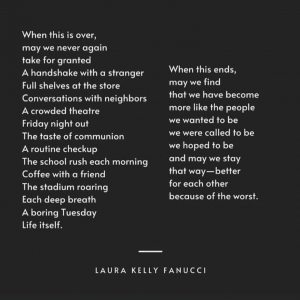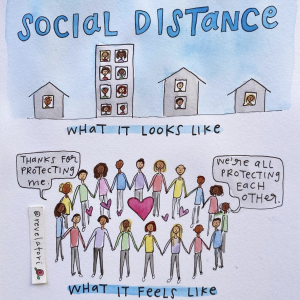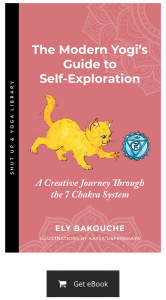For the past two months, China has been on lockdown.
Since the beginning of the COVID-19 outbreak in January, our lives have been slow. We put business projects on hold; we rearranged our routines and habits to match our new priority: avoid contact as much as possible to limit the spread of the contagious virus.
I’m an introvert, and I usually like staying home. I like it when things go slow, too. And yet, I found myself craving human contact during this time of isolation. I even missed walking side by side on the street with strangers. But physical solitude wasn’t the only challenge. In an attempt to ban the spread of misinformation, China had increased cybersecurity, and it became impossible to log into WhatsApp, Gmail, and all social media platforms. Suddenly, being in touch with loved ones got difficult. I also lost access to YouTube, Netflix, and Vimeo, which meant that I couldn’t practice yoga from home as I usually do.
In the beginning, our days were filled with uncertainty and pros-and-cons list making. Having been expats in China since last summer, we wondered, do we go back to Europe? Do we escape to a nearby country to wait for things to calm down? Do we stay here and just… wait? We ended up staying put, following the government’s recommendations and getting amused at the creative ways hygiene messages were communicated in every WeChat group.
W ash your hands
U se your mask properly
H ave your temperature checked regularly
A void large crowds
N ever touch your face with unclean hands
Right now, though, things are slowly getting back to normal. A couple of “non-essential” stores are open again, and people are talking about schools opening before the summer. Events are tentatively scheduled for the end of April. Masks are still mandatory, temperature checks and green QR codes [the ‘health’ ID card the Chinese government created to make sure you aren’t putting others at risk] required upon entering all buildings. Cafes and parks are mostly empty or closed, but life is coming back. We are cautiously celebrating the ability to meet up with friends for coffee, to have chats with the owners of local restaurants, and to book (!) a workout at the gym.

I am here to send optimistic energies and share what has helped me over the past weeks. I am here with words of encouragement—even with lots of uncertainty floating over our heads here in China, we have been able to find ways to keep living and finding peace and comfort in our day to day. I am here to remind you that while we must prioritize the safety of all, we also have the right to do things that help us stay sane and mentally and physically well.
Without further ado, here is a list of ideas. Take what speaks to your heart, mind, and body, and leave the rest!
A Note on Checking the News
Now, more than ever, it’s important to exercise our critical thinking, so we can navigate the polluted information field. BuzzFeed recently covered the rise of the coronavirus influencers, and the sheer number of self-proclaimed experts is chilling. Early on, I decided to pick one source of information to check on a daily basis. A French doctor specialized in solutions for public health in Shanghai sent updates every morning in a WeChat group message chain, and that was all I consulted. Here’s what I recommend:
- Pick one high quality, well-informed, trustworthy platform, or even better, a single columnist to follow, and forget about the rest.
- Schedule a time of day to check in. Set a timer if you know you might fall down the rabbit hole of news, and stop when the time is up. You don’t have to check the news every day if that overwhelms you.
- Let your mind process what you’ve just read or watched before you move on with a task. Journal or sing, dance, doodle, talk about your feelings if you need to.

Check your priorities
In hindsight, I wish someone had told me this all those weeks ago. I panicked over the fact that I wouldn’t be able to answer my emails due to the enhanced government firewall. And I wasn’t even able to call my sisters and best friends! Weren’t my priorities a little off? I wish I’d given myself time to feel the news and be fully present with what I was experiencing in face of this challenge.
Now that you aren’t able to practice at your local yoga studio, visit your favorite shops, go to work, or spend time with your friends as usual, it might be tempting to tackle the daunting to-do list you kept pushing for when you’d have more time. We are humans, not machines. Productivity and business aren’t everything. Allow yourself time to process whatever it is you are feeling. So much can show up; confusion, fear, gratitude, concern… Adjust your schedule so it includes the important things, like staying in touch with your friends and family, moving regularly, creating peace-inducing spaces, and finding creative ways to spend time online with your communities.
Video call your loved ones
Let’s be honest, we often neglect to dedicate sufficient time for connecting with other human beings. Instead, we worry that our lives are falling apart, and then we spend all awake hours of the day running a self-imposed rat race towards the best solutions and actions to take right now. Yet, sometimes all we need is a heart-felt conversation to have the energy and peace of mind to keep going. Let your relationships nourish you!
If online communication doesn’t come easy to you, here are two ideas to make it smoother:
- Schedule time in your calendar for daily communication. Most of my friends and family are in Europe, so at least a couple of days a week, I try to reserve 5-7 pm, their morning time, for catch up calls. Scheduling it helps me be fully present with them without calculating how much time I have left to tackle my to-do list.
- Get creative with the format. Instead of meeting up for an actual coffee, make yourself a nice cup of something and make yourself cozy. You can arrange virtual board game nights, watch Netflix together with their new Netflix Party feature, or even cook together. To many of us, this will be obvious but… Do turn on the camera!

Move throughout the day
With the neighbourhood gym closed, I decided to go for walks on the empty streets of Shanghai. It felt both exhilarating (what a rebel!) and a little depressing too (Shanghai is a 20-million people city, and seeing it empty was a surreal experience).
But moving every day, albeit wearing an uncomfortable face mask, looking at the sky, and smelling the blooming flowers, gave me so much hope and joy. Changing my environment helped me see things from a different angle. Of course, I’m not suggesting you break the rules and go against your local guidelines. If you do have the chance, though, find yourself empty walking spaces and use them!
Dancing also became a new weekly normal for my partner and I. Every Friday night, we greeted the weekend with lots of silly moves, a little salsa, jumping, and off-tune singing. No partner? No problem! Dancing with yourself works too, and so does organizing an online dance party.It’s been a fun and joyful way to lighten up the mood.
During this time, I also finished reading Move Your DNA by Katy Bowman. Among other things, she teaches lots of ways to move throughout the day and encourages sitting in many different shapes on the floor. Building a new movement routine and learning more about my body has made a big difference in my day-to-day awareness.
To organize your workspace creatively, grab pillows, blocks, bolsters, and rolled up mats you have around the house. If you can, pick a spot near a source of natural light. For the seated positions, sit down on enough pillows. Make sure that your pelvis isn’t tucked under and hinge from your hips to tilt forward slightly. Here are my favorite options:
Seated
- Seated butterfly. Put the soles of your feet together, as close or far from your body as you need.
- Wide-legged sit. Extend your legs out in a V. Switch up the distance between your two legs for variety, and remember to wiggle your toes!
- Sitting on your heels. Come onto your knees and sit on your heels. Tuck your toes under, untuck them; you can even place something in between your heels and your hips to make it easier for your pelvis.
Standing(ish)
- Supported squat. Grab a bolster, folded blanket, or rolled mat and place your heels on it. Squat down and try not to round your back. I like to put the back of my arms on my knees (the fleshy upper part), it’s more comfortable for my back (works for a short while and to get blood flowing rather than extended periods of time)
- Balancing-ish on a soft surface. Place your feet on a bolster, folded blanket, or rolled mat in different ways. Place your feet parallel across your prop or one foot in front of the other on it.
Create white space
Create white space moments when you aren’t checking the news, doing work, watching or listening to any more content. Our nervous systems are usually overloaded, but during these times, they are in complete overdrive, so giving the content consumption a break is absolutely necessary. I repeat, giving the erratic content consumption a break is absolutely necessary—yes, I’m looking at you, Netflix.
White space helps us get lost in our breath, in the flow, in a story that takes our minds off of the seriousness of life. It facilitates time where we can be kind, patient, and compassionate with ourselves. On our modern yoga planet, we usually think this has to mean meditating, doing breathing exercises, or a restorative asana practice, but there are many more ways we can find that flow.
Here are a few things I did to create white space:
- Take legs up the wall with soothing nature sounds playing in the background (or with the window open)
- Color and paint in a book that tells me where to put color and what kind of material I need (which is great to limit decision-fatigue and the intimidating blank page)
- Bake and cook
- Read fiction
- Forget about plans
- Staying off social media (even when the Chinese firewall allowed for it)
Here are two things I really wish I were able to do:
- Cuddle with a dog
- Pet a cat and hear him/her purr for hours on end
- Take long walks immersed in nature, like a forest, lakeshore, or beach
Yes, this is an invitation for you to do it if you can. I am sure it will feel delightful!
Look after and spend time in your community
In China, the only platform you need is WeChat. It’s a mix of WhatsApp, Facebook, Instagram, Apple or Google Pay, and even Craigslist. Every local community has a group on there. You can find religious groups, buy & sell groups, charity groups, event groups, groups for foreigners of every single country. It’s a little overwhelming at times, but in times like these, this virtual space is a source of comfort and life.
I saw companies organize webinars to help small businesses navigate the economic challenge of having to stop almost all activities. I was invited to Zoom events for community gatherings on the weekends. People shared heart-warming news from a struggling Wuhan and the positive things they were experiencing because of the lockdown—like more time than ever spent with a partner as a result of working from home.

Here’s what you can do for and with your community:
- If and when possible, keep doing what you were doing, online.
- Organize or attend new things online: movie nights with friends, simple games like taboo or charades, coworking sessions…
- Start a club: book club, baking club, a cute cat videos club… Create a message chain and set a couple of rules (e.g., COVID-19-free zone, keep the content in line with the topic of the club, etc.).
- Check in on each other regularly – you can create a weekly online meetup where everyone can take turns sharing what they’re feeling and what has been on their minds to make sure everyone gets heard regularly. The point isn’t to offer solutions, but simply listen, as sometimes all we need is a kind ear.
- Offer your help while being mindful of your energy limits and personal boundaries. I repeat, be mindful of your own boundaries!
Just slow down
A friend of mine who lives in Israel texted me the other day sharing that she’d bought everything to make macrame, arts and crafts, to sew, and more. She is a true social bee, always out and about, meeting up here, dancing there, having drinks and dinners with her friends.
Right now, some things can wait. Let’s all follow her lead and get our arts and crafts supplies to make time spent at home fun, playful, and full of learning experiences.
Re-evaluate your boundaries
Now is as good a time as ever to say no to what doesn’t feel right, good, or helpful. Everyone is going through a difficult time, including you. Those who love you will understand that you might need time alone and away from your phone. Whether you are an introvert or an extrovert, we all need rest and recharge.
Ask yourself if you have the capacity for a chat or giving a hand before extending out an invitation. Help yourself first—and remember that whole you can’t pour from an empty cup idea.
Think about professional boundaries, too. If you are someone people turn to for help, advice, or tools, it is okay not to give your all like you usually do. And if you see others in your community handing out tips, free classes, or ways to navigate crises, it doesn’t mean you have to do it too.
There is no right way to respond to times like these. We all do the best we can with the tools we have, and sometimes we need to sleep and listen to our guts and hearts.
Here are a few practical ideas on establishing boundaries:
- Tell loved ones if you don’t have the energy to talk about the virus or any other stress- and anxiety-triggering topics.
- Make a list, doodle, paint, draw… your needs, and how you are currently meeting them.
- Re-evaluate what habits and routines you have in place so they meet your current needs. Pick the ones that feel most comforting; don’t force anything on yourself right now.
- Like with the news, set a time of day and time limit for your social media consumption. While social media can help us feel connected, they can also trigger anxiety. Focus on what brings you value and comfort, and leave the rest out.

Don’t be afraid to change things up right now. My latest boundaries involve checking emails less often and starting work after I’ve done something that bring me peace and joy (a walk, a fiction read).
Cultivate self-compassion
When we are safe and healthy, it’s easy to think that a) we must do something to help, and b) we aren’t allowed to feel what others are experiencing in more challenging situations. Remember that no matter who or where you are, you are human with feelings, too, and only two hands and one heart to extend out.
To counter idea (a), take this time to be gentle, kind, and loving towards yourself the way you are with your favorite people. Again, no one really knows what the best thing to do right now is, and you are, like everyone else, doing your best. Can you actively listen to yourself a little more? Can you take some weight off your shoulders by taking non-urgent things off your to-do list? Find your ground first, then assist others.

To counter idea (b), keep in mind that there is no hierarchy of pain. No one is immune to fear, despair, frustration, anxiety, or loneliness. Allow yourself to feel whatever you need to feel (walks and your preferred white space activity will help). Everything you are experiencing right now is valid and worth your attention. Hug yourself if that helps!
Cultivate perspective
Sometimes we simply get stuck in our heads, chewing on the same bites of thoughts for hours on end without finding a way out. Putting things into perspective is grounding and reassuring—two feelings we really need in times of crisis.
Perspective isn’t about looking for the positive; instead, it’s about zooming out to see the bigger picture. Seeing things from a distance brings clarity, which in turn grounds us down. Here’s how you can create that sense of perspective:
- Take stock of the things you have access to. For me, not having access to WhatsApp proved hard, and I tried to find reassurance in that I still had access to WeChat to call my parents and be in touch with local friends.
- Establish what you have control over, and what you don’t. Once you are clear on these, you’ll be able to dedicate your energy to what you can change and leave the rest. I spent a lot of time worrying about the Internet access situation. After a week of frustration, I saw it as a way to work less and to dedicate more time to creative tasks. It took some time, but I got there. As it turned out, spending an hour reading a fascinating book is much more enjoyable than sitting at my computer waiting for the damn VPN to turn on so I could access Google Drive (it never did).
Be creative with the internet!
I feel lucky that being an introvert and location independent (and often on the road) has taught me to look for and use online communities to build and cultivate long-distance relationships. I turned to my online community on a weekly, if not daily basis, and attended as many online events as possible. It helped keep me sane and think about other things—especially since, at that time, few people outside of China were concerned about the situation.
Having to stay home doesn’t mean everything has to stop. Turn to the internet and use its incredible potential. Go down the rabbit hole of your favorite topic of research. Have fun creating a playlist. Have online movie nights and spontaneous Zumba parties with your friends. The (online) world is your oyster!
Resources
It’s my favorite app for meditation for its check-in function—it reduces decision fatigue. It gives you a few seconds to notice how you feel mentally and physically and then creates a tailored list of meditations based on that.
Coursera Course to learn about COVID-19
Understanding facts can help us ground down. The course is offered by the Imperial College London, and it’s free!
Quarantine + Creativity, a place to collect, connect, and share all the positive outcomes from around the globe. You can submit your own creations or check out the resources and submissions.
Startups Fighting to Flatten the COVID-19 Curve by AngelList. It features a list of startups finding ways to care for their communities.
Reads
COVID-19 Isn’t Just a Medical Crisis—It’s an Existential One by Double Blind Mag, on how slowing down forces us to think about the bigger questions.
What China’s Coronavirus Response Can Teach The Rest of The World by Nature, on how successful extreme limitations on population movement have been to limit the spread of the virus. (Note: When reading the numbers, keep in mind that China has 1.4 billion inhabitants and that Chinese citizens are extremely compliant with the law.)
Online communities
Digital Nomad Girls, a Facebook group and membership platform for all location independent freelancers and entrepreneurs looking for moral support while on the road.
Ultraworking, a platform that provides online coworking sessions to keep up with your productivity if you have a hard time focusing, whether you have a team or usually work solo.
What are your communities doing online right now to support the challenge we are collectively experiencing? Share them with us!
Edited by Anastasia Buterina





